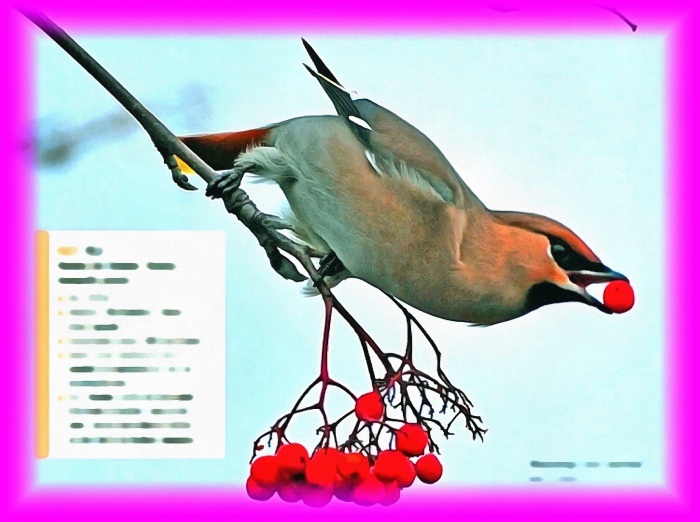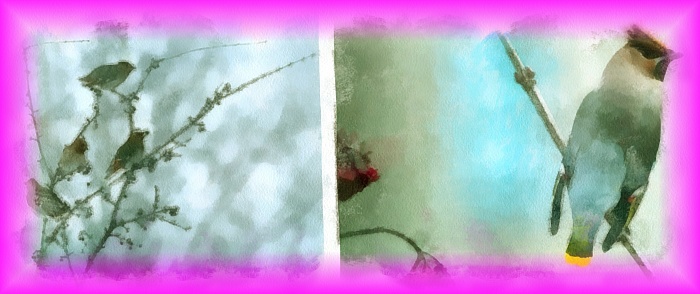The City, Winter and Bohemian Waxwing
Очередной выпуск моего авторского Блога.
To give us a break from this boring summer heat, let's take a look at the waxwing, a bird that represents a classic winter cityscape day :-)
Блог #70 | Another kind of bird...

Move over Mr Robin, this festive favourite is keen to take your Christmas crown...
FACT FILE:
Waxwing (aka Bohemian Waxwing)
Bombycilla garrulus
Size: 18-21cm
Relatives: Silky-flycatchers, Palmchat
& Grey Hypocolius
Conservation status: IUCN Least Concern
Known urban locations to find it:
potentially at a supermarket car park near
you during the winter
Fact: Waxwings are the only birds outside
of the tropics to feed their young on fruit.
Indeed, they are more reliant on fruit than
any other bird in the Northern Hemisphere
Waxwing
To take your mind off the heat of
summer, let’s look at the Waxwing,
a bird that epitomises a classic
winter’s day of urban birding.
It is a species that, whenever flocks appear
within our urban areas, has pulses
racing and cameras raised.
But let me say this: roll over Robin,
as this sexy, gregarious Scandinavian
should be Britain’s new Christmas card pin-up.

I have been privately campaigning for years for
the Bohemian Waxwing, as it is fully known,
to be immortalised and recognised on festive
mantlepieces across the nation. Pipe dream?
Perhaps. But take a good look at this bird.
Check out its amazing grey-mauve-pink hues,
wispy crest, its yellow tail-tip and the red,
blob-like feathers on its wings that look like wax
drops (giving the bird its name).
In my view, they all combine
to produce a bird rich in character
and colour far surpassing that of the
Robin, who only has a red
breast to show for itself.
And, like the familiar Robin, you can
sometimes walk right up to them, but
they hang out in flocks.
Robins don’t.
This means that you could be treated
to multiple views plus, they don’t
fight each other as they are very peace
loving. Isn’t that what
Christmas is supposed to be about?
I hope that you are convinced
by my campaign pitch. Go Team Waxwing!
But what is a Waxwing?
Our Bohemian Waxwing is one
of three species worldwide that also
includes the Cedar and Japanese Waxwings.
All are superficially similar looking, in
that, at first glance you would not mistake
them for anything other than a waxwing.

Of the three, the Japanese Waxwing is the most
range restricted, breeding within the coniferous
forests in the Russian Far East
and a tiny part of north-east China.
It winters in Japan, Korea and eastern China.
The Cedar Waxwing has a solely
North American distribution, whereas the
Bohemian Waxwing enjoys a range
across the northern forests of the
Palearctic and North America.
There has been a lot of conjecture
about which families the
waxwings are related to.
The current thinking seems to link them
to a disparate group of birds including the
New World silky-flycatchers and Hawaiian
honeycreepers, plus to the Old World oddity,
the Grey Hypocolius, which is found in dry
semi-desert regions from
North Africa east into western India.
As a kid, I always dreamt of discovering
a Waxwing or two during a winter’s wander
around the streets of London.
But I was never successful.
I subsequently learnt that the
numbers wintering in the UK varies greatly
from year to year, as a reflection
of their supply of berries further north.
I also did not appreciate their
superficial similarity to Starlings
when they flight between locations.
They share the same ‘Harrier jump jet’ shape
but are slighter and smaller than said Starlings,
with a curious trilling flight call.
Thus, it is possible that I
could have missed a few in my time.
However, I do clearly remember seeing my
first Waxwing.
It was during an ill-fated twitch
in January 1989 to see the Western Palearctic’s
and Britain’s first (and to date, only) Golden-
winged Warbler that decided to take up
residence around the bushes of a Tesco customer
car park in Larkfield, Kent, instead of the more
usual exotic climes of South America.
However, the first bird I saw
when I stepped out of the car
was a single, glorious Waxwing.

I didn’t have the time to celebrate
this much-wanted addition
to my list as I had more
serious matters at hand.
Needless to say, my search for the warbler,
among a throng of 3,000 other twitchers,
eventually proved to be painfully fruitless.
I still have never seen a Golden-winged Warbler,
even in their native areas in the Americas.
However, I have happily seen thousands of
Waxwings since. One of my most memorable
encounters was with a flock of 120 feeding
on Rowan berries on a street off Tottenham
Court Road in Central London.
Commuters were rushing to
their offices while parties
of these northern gems were busily stuffing
their faces literally inches above their heads.
It shocked me to see that not one of the
commuters looked up to marvel at the birds.
So, Waxwings are quite urban, and it seems
the best places to look for them are the areas
where councils have planted
fruit-bearing ornamental trees.
The birds are not true long-distance
migrants but instead perform ‘irruptions’
sometimes in flocks numbering into
their thousands well beyond their normal range
to be found as far south as Spain.
To give you an idea of the
potential scale of these movements,
the largest recorded European irruption, so far,
was during the winter of 2004/05 when more
than 500,000 were recorded in Germany alone.
It is said that a good indicator of whether
we are going to be treated to a fine Waxwing
winter in the UK is to gauge the number
of birds that turn up in
Aberdeen during November.
If they record large flocks, then the rest
of us can start wringing our hangs
with anticipation and glee.
Проект Fixed Matches Betting
© 2015 - This is a consulting website by Ruslan Bekhterev